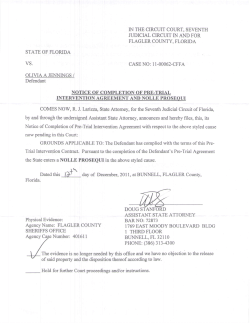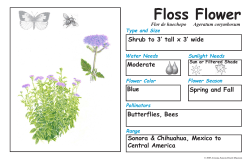
Millettia pinnata. Publication5.pub
Pongam (Millettia pinnata): Distribution, Identification and Uses Stephen H. Brown, Lee County Horticulture Agent brownsh@ufl.edu Kitty Tyler, Lee County Master Gardener Mid-November Racemes with flowers. Mid-May. Family: Fabaceae Common Names: Pongam, Pongamia Synonyms (discarded names): Cytisus pinnatus, Derris indica, Galedupa indica, G. pinnata, Pongamia mitis, P. pinnata Origin: From Indo-Malaysia to Australia U.S.D.A. Zone: (9B-12B (25ºF minimum) Plant Type: Medium to large tree Growth Rate: Fast Typical Dimension: 35’x55’ Shade Density: Heavy Leaf Persistence: Briefly semi-deciduous Flowering Season: Spring Intense Blooming Days: 23 Flower Color: Pinkish, mauve or white Light Requirements: Full sun to part shade Soil Requirements: Wide Drought Tolerance: High Soil Salt Tolerance: Medium to high Aerosol Salt Tolerance: High Wind Tolerance: High Nutritional Requirements: Medium Propagation: Seeds Motility: Self seeding IFAS Assessment: Caution in South Florida; not problematic in Central and North Florida Human hazards: Toxic seeds Major Potential Problems: Nutritional deficiencies, Sri Lanka weevils Uses: Shade tree, flowering tree, seaside tree, street tree, screening, oily seeds used for illumination and bio-fuel Nativity and Distribution Pongam (Millettia pinnata) has a wide naturally occurring range from India east to Australia and New Guinea. It is widespread in coastal areas, tidal streams, mangrove forests and the flats of humid rivers. It was introduced to the United States in 1910 and grows well throughout Florida and Southern California. It is potentially a weedy species wherever it is introduced. Seed pods. Early January. 2 Growth Habit This is an erect fast growing single trunk or multi-trunked tree usually from 32 to 40 feet tall. The trunk is stout and the bark smooth and gray-brown. It is heavily foliated with dark green leaves, a rounded symmetrical crown which flattens at the top with age, with somewhat drooping branches. The tree is more or less deciduous, losing it leaves in late winter or early spring (February-March) and regrowth beginning in April and May. Normally there is only one extended period of renewal growth each year. The renewal shoots, especially those on saplings are long, arching little-branched with spirally-arranged leaves. Two or more branches can arise at the same node, both of them flowering branches, or vegetative and flowering branches intermixed. Dense canopy and drooping branches. Mid-November. Regrowth begins. Late April. Seed pods are plentiful on semi-deciduous tree. Same tree. Early June. 3 Leaves The compound leaves are alternate, usually 6 to 8 inches long. The leaf includes a 1.5 inch petiole that is swollen at its base. They are odd-pinnate, with mostly 7, sometimes 5 or 9 ovate or broadly elliptic leaflets. Leaflets on the rachis are oppositely placed. Leaflets are entire, commonly 3 to 4 inches long and 1.5 to 2 inches wide. They are glossy and dark green above and pale green below. The canopy is pinkish -red when new leaves are emerging. It becomes dark green when emergent is completed. Dense foliage. Early November Seven leaflets form an odd-pinnate leaf. Flowers and Flowering Flowers appear en masse from April to July, peaking in April and May. Flowering begins after the completion of renewal growth. There is an average of 23 intense blooming days. Flowers are produced on racemes from either new terminal stem growth or from short new lateral flowering stems, both arising from older growth. The racemes are up to 5 inches long and consist of loose clusters of flowers. The flowers are small, 0.8 inches long including a 0.25 inch pedicel. They are faintly scented, pendent, and papilionaceous (pea-like). Petals are pinkish, mauve or white and set in purplish brown calyxes. The standard (the upper main petal) is erect and hooded. At its peak, there is a modest display of flowers as many of the flowers are concealed by the tree’s dense foliage. Short-lived flowers are followed by many woody seed pods. Lateral flowering stem Terminal flowering stem Old growth (gray wood) Peak bloom. Late April. Lateral and terminal flowering stems. Late April. New growth flowering stems have green wood. 4 Racemes. Early May. Flowers are approximately 0.8 inches long with a hooded standard. Fruit The fruit is a flat, woody, broadly elliptic-oval, yellow to brown indehiscent pod. It is up to 2 inches long and an inch wide, with incurving points, a stout stalk, and contains a single large seed. Fruit set is abundant and many remain on the tree up to the time of leaf regrowth during the spring of the following year. Broad, woody pods. Tree laden with seed pods. Early January. Leaves, racemes, pods and seed. 5 Uses Pongam is used as a medium-sized shade or flowering tree. The seeds and roots can be used to stun fish which are then collected for food. The leaves and young growth are fed to cattle and other animals, especially in times of drought. Oil extracted from the seeds has been used as an ointment, as a lamp fuel, and for the production of biodiesel. Management Pongam should be grown in full sun or partial shade in well-drained soil. It is a relatively low– maintenance tree once established. It will show nutritional deficiencies if grown in soil with a pH above 7.5. The flowers and pods produce copious litter under the tree. This occurs several months apart. The pods are stone-like and require cleanup after falling. Pods are poisonous, a fact which should be considered in placing the tree in the landscape, if any small children are present. The tree has no major disease problems. Sri Lanka weevils and caterpillars make infrequent appearance on the tree. According to the UF/IFAS Assessment of the Statue of Non-Native Plants in Florida’s Natural Area, Millittia pinnata may be used with caution in south Florida, but should be managed to prevent its escape. It is not considered a problem species and may be used in central and northern growing zones of Florida. Flower petals strewn on a sidewalk. Late April. Pendent seed pods just before flowering. Late April. 6 New foliage just before bloom. Early May. Tree in full bloom. Late May. 7 References Bailey, L.H. 1937. The Standard Cyclopedia of Horticulture. The Macmillan Company, New York Barwick, M. 2004. Tropical & Subtropical Trees: An Encyclopedia Timber Press, Inc. Portland, Oregon Brown, S.H. 2014. South Florida Shade Trees: Identifications and Selections. UF/IFAS Lee County Extension Service, Fort Myers, Florida Gilman, E. and D.G. Watson. 2014. Pongamia pinnata: Pongam. ENH657. UF/IFAS Extension, Gainesville, Florida Nelson, G. 2010. The Trees of Florida. A Reference and Field Guide. Pineapple Press, Sarasota, Florida Staples, G. and D.A. Herbst. 2005.Tropical Garden Flora: Plants cultivated in the Hawaiian Islands and other Tropical Places. Bishop Museum Press, Honolulu, Hawai’i Tomlinson, P.B. 1980. The Biology of Trees Native to Tropical Florida. Harvard Printing Office, Allston, Massachusetts Watkins, J. V. and T.J. Sheehan. 1975. Florida Landscape Plants. University of Florida Press, Gainesville, Florida Tree Links African Tulip Desert Rose Eucalyptus Trees Hong Kong Orchid Jaboticaba Jacaranda Norfolk Island Pine Hurricane Recovery Pigeon Plum Royal Poinciana Seagrape Simpson’s Stopper Starburst Clerodendrum Tamarind Wild Tamarind Yellow Elder Yellow Tabebuias YouTube Landscape Channel Stephen H. Brown’s Web Page All pictures taken by Stephen H. Brown This fact sheet was reviewed by Peggy Cruz, Lee County Extension. Pat Rooney, Lee County Master Gardener. The Institute of Food and Agricultural Sciences (IFAS) is an Equal Opportunity Institution authorized to provide research, educational information and other services only to individuals and institutions that function with non-discrimination with respect to race, religion, age, disability, sex, sexual orientation, martial status, national origin, political opinions or affiliations. U.S. Department of Agriculture, Cooperative Extension Service, University of Florida, IFAS, Florida A. & M. 5/2015 Return to first page.
© Copyright 2024











